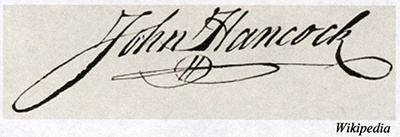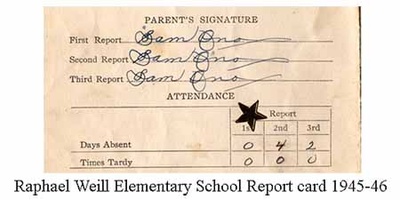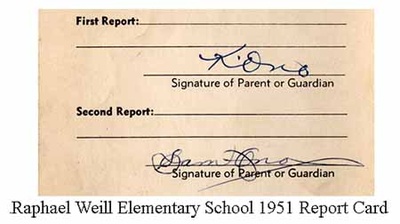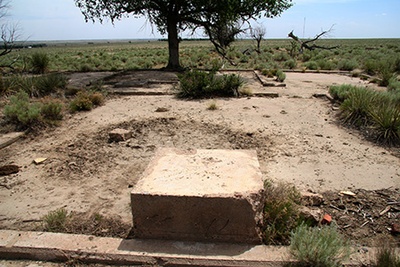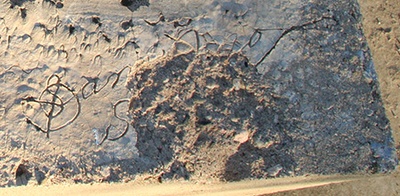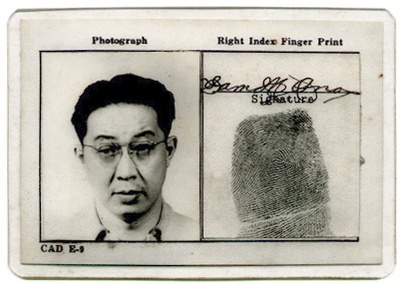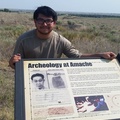Most everyone has heard the phrase, “Put your John Hancock right here.” John Hancock, a key signatory of the Declaration of Independence, was remembered for his large and stylish signature and whose name has became synonymous for signature.
While our father’s signature is not famous, it too was confidently large and stylish. While we were in grade school my brothers, sisters and I sought his signature on our report cards. He would only sign the report cards that had mostly good grades. Otherwise, my mother would sign.
As seen on the back of my late 1945-46 report card from Raphael Weill Elementary School in San Francisco, I aced it in Junior Primary! This followed our recent return from Amache, the War Relocation Authority concentration camp near Granada, Colorado where our families were imprisoned during WWII.
That was my only perfect report card. As shown in a 1951, 6th grade report card (below), both my parent’s signature appear on what were the more typical cards I received in Raphael Weill after my overwhelmingly successful coup in Junior Primary. I do remember really liking my kind and beautiful teacher, Miss Hird.
Imagine my surprise as an over-60 grandfather discovering this very same signature written in concrete 65-years ago on the Amache site on July 1, 2008.
My 16-year-old grandson, Dante Hilton-Ono and I were guest volunteers to work for two-weeks at Amache with a University of Denver archaeological dig crew led by Dr. Bonnie Clark, assistant professor of the Anthropology Department.
On the second morning of our stint, Dante had already been assigned to a dig site with some DU students. Dr. Clark and I were walking towards another survey area on the end of Block 9L, where other student crew members were setting up. As we walked over the concrete foundation of what was the laundry/shower barrack, Dr. Clark pointed out a concrete block about three-foot square that the workers who poured the concrete base had evidently signed.
As I approached the concrete block, which was the base for a water boiler, I could not believe what I was seeing! Unbeknownst to Dr. Clark, one of the signatures was my father’s! I excitedly pointed out the unmistakable stylized letter S of his signature. Part of the signature was broken away, but the top portion of the “Ono” and his long flourished stroke to the right is easily seen. The pictures below were taken on two different days and times for the different lighting affect. Dr. Clark and I were just awe-struck at this chance discovery.
Later in the day, I showed Dr. Clark a copy of my father’s signature on his WRA ID card below. (Note: that on this card he signed it with his middle initial M, for Masami. Not so, on the report cards)
Evidently, along with the other block signers, my father was proud enough of his concrete handiwork to put his “John Hancock” there. Ironically, Amache the concentration camp, was not exactly the ideal place to sign - - - a declaration of independence!
Now, let’s try and find out who the other signers are.
Enlarging both photographs of the full top of the concrete block to better read the three signatures other than my father’s, I was better able to make out the last names: Sato, Iwamura and Kagiyama or Kageyama.
Fortunately, I had the use of the earliest Amache Directory dated January 1943. This was important because my father was recruited and left Amache to work in Denver, Colorado in April 1943 and so, before that could have been the only time when he and the others signed the concrete block.
Looking up their family names in the directory made deciphering their first names easier. I came up with:
- Morio Sato, 8F-12A, w/Kimie and Marie
- Minoru Iwamura, 9H-3B
- Masao Kageyama, 11F-5F, with Hatsuko Lou and Masao Jr.
*Recent discovery! Masao Jr. turned out to be none other than Rodney Kageyama, renowned film and stage character and comedic actor and an important volunteer at the Japanese American National Museum!
If anyone recognizes these names or know of their family members, please let them know about the significant signatures, which are now historically documented. I will provide them with a photograph of the concrete pedestal. garyono@sbcglobal.net or (213) 613-0760.
©2009 Gary Ono


